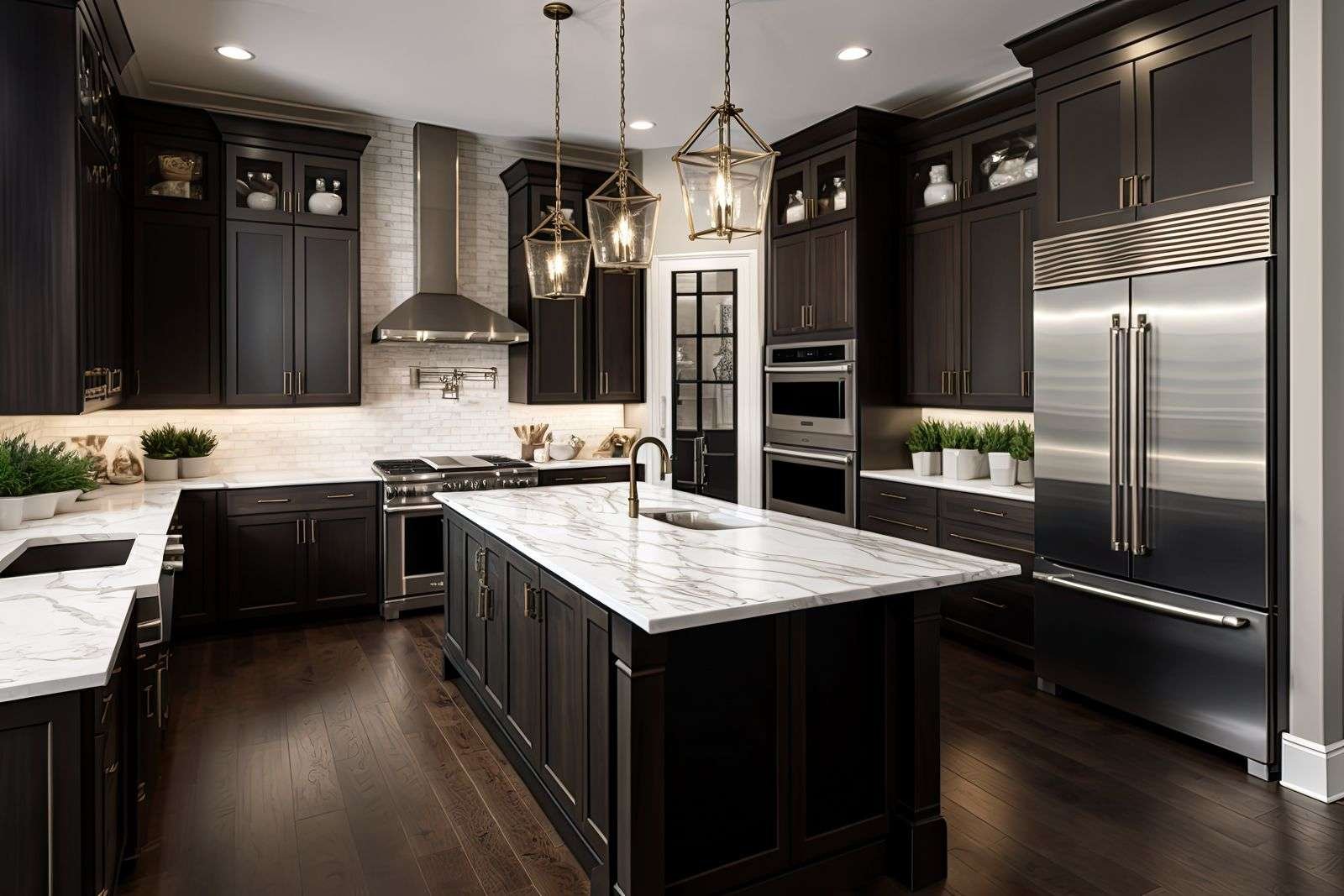Eco-Friendly Kitchen Renovation Ideas
Renovating your kitchen is an exciting project, but it can also have a significant impact on the environment. Making eco-friendly choices not only helps reduce your carbon footprint but can also create a healthier home for you and your family. Here are some practical tips for making your kitchen renovation environmentally friendly.
1. Choose Sustainable Materials
Bamboo Cabinets and Flooring: Bamboo is a fast-growing, renewable resource that makes an excellent alternative to traditional hardwoods. It’s durable, attractive, and available in various styles and finishes. Using bamboo for cabinets or flooring is a great way to add a natural touch to your kitchen while being eco-conscious.
Reclaimed Wood: Incorporating reclaimed wood into your kitchen design is a fantastic way to reuse materials and reduce waste. Reclaimed wood can be used for cabinets, flooring, and even countertops, providing a rustic and unique aesthetic.
Recycled Glass Countertops: Recycled glass countertops are made from crushed glass set in a durable resin or concrete base. They come in a wide range of colors and patterns, offering a beautiful and sustainable alternative to traditional countertop materials.
Recycled Metal: Using recycled metal for elements like backsplashes, fixtures, and even cabinetry can add a modern, industrial look to your kitchen while reducing the demand for new raw materials.
2. Opt for Energy-Efficient Appliances
Energy Star Appliances: When selecting new appliances, look for the Energy Star label. Energy Star appliances meet strict energy efficiency guidelines set by the U.S. Environmental Protection Agency, which means they use less energy and water than standard models. This not only helps the environment but can also save you money on utility bills.
Induction Cooktops: Induction cooktops are more energy-efficient than traditional gas or electric stoves because they use electromagnetic energy to heat pots and pans directly. This method reduces energy loss and cooks food faster.
Efficient Dishwashers: Modern dishwashers are designed to use less water and energy. Look for models with eco-friendly features such as soil sensors, which adjust the water usage based on how dirty the dishes are, and half-load options for smaller loads.
3. Improve Insulation and Ventilation
Insulate Walls and Floors: Proper insulation in your kitchen can help maintain a comfortable temperature and reduce the need for heating and cooling. Insulating walls, floors, and even the underside of countertops can make a big difference in energy efficiency.
Energy-Efficient Windows and Doors: Replacing old windows and doors with energy-efficient models can prevent drafts and heat loss. Look for windows with double glazing and low-emissivity (Low-E) coatings, which help reflect heat back into the room.
Proper Ventilation: Good ventilation is crucial for maintaining indoor air quality and reducing humidity, which can lead to mold growth. Consider installing an energy-efficient range hood and make sure your kitchen has adequate exhaust fans.
4. Use Low-VOC Paints and Finishes
Low-VOC and Zero-VOC Paints: Volatile organic compounds (VOCs) are chemicals found in many paints and finishes that can release harmful fumes into the air. Choosing low-VOC or zero-VOC paints and finishes can significantly improve the air quality in your home and reduce your exposure to toxic chemicals.
Natural Finishes: Look for natural finishes made from ingredients like beeswax, linseed oil, or water-based solutions. These options are not only safer for your health but also better for the environment.
5. Incorporate Green Lighting Solutions
LED Lighting: LED lights use up to 80% less energy than traditional incandescent bulbs and last significantly longer. They are available in various colors and styles, making them a versatile choice for any kitchen design.
Natural Light: Maximizing natural light can reduce the need for artificial lighting and make your kitchen feel more open and inviting. Consider installing skylights, larger windows, or light tubes to bring more daylight into your space.
Smart Lighting Systems: Smart lighting systems allow you to control your kitchen lights remotely or set them on a schedule, reducing energy waste. Many smart lights can also adjust their brightness based on the time of day, further enhancing energy efficiency.
6. Water-Saving Fixtures
Low-Flow Faucets: Installing low-flow faucets can reduce water usage without sacrificing performance. Look for faucets with the WaterSense label, which indicates they use at least 20% less water than standard models.
Efficient Sinks: Consider a sink with an integrated water-saving feature, such as a sensor-activated faucet or a dual-basin design that allows for more efficient washing and rinsing.
Water Filtration Systems: Installing a water filtration system can provide clean, safe drinking water without the need for bottled water, reducing plastic waste.
7. Sustainable Cabinetry and Furniture
Formaldehyde-Free Cabinets: Many cabinets are made with particleboard or plywood that contains formaldehyde, a harmful chemical. Look for cabinets made from formaldehyde-free materials or solid wood options with non-toxic finishes.
Eco-Friendly Furniture: Choose furniture made from sustainable materials such as reclaimed wood, bamboo, or recycled metal. Avoid products treated with harmful chemicals and opt for pieces made with natural or water-based finishes.
Modular Cabinets: Modular cabinets can be easily reconfigured or expanded as your needs change, reducing the need for new materials and minimizing waste.
8. Reduce, Reuse, Recycle
Repurpose Existing Materials: Before buying new materials, consider repurposing items you already have. Old cabinets can be refinished or painted, and existing countertops can be resurfaced to give them a new look.
Donate Unwanted Items: If you’re replacing old appliances or cabinets, consider donating them to a local charity or recycling center. Many organizations will accept gently used items and give them a second life.
Recycle Renovation Waste: During your renovation, make sure to recycle materials like metal, glass, and plastic. Proper disposal of hazardous materials, such as paint and solvents, is also crucial for minimizing environmental impact.
9. Mindful Flooring Choices
Cork Flooring: Cork is a renewable resource harvested from the bark of cork oak trees. It’s naturally resistant to mold, mildew, and pests, making it a durable and eco-friendly flooring option for kitchens.
Linoleum: Unlike vinyl flooring, linoleum is made from natural materials like linseed oil, cork dust, and wood flour. It’s biodegradable, durable, and available in a wide range of colors and patterns.
Concrete Flooring: Concrete can be an eco-friendly flooring option when made with recycled materials and sealed with non-toxic finishes. It’s highly durable and can be polished to create a sleek, modern look.
10. Eco-Friendly Cleaning and Maintenance
Natural Cleaning Products: Switch to natural cleaning products that are free from harsh chemicals. Ingredients like vinegar, baking soda, and lemon can effectively clean various kitchen surfaces without harming the environment.
Reusable Cleaning Cloths: Reduce waste by using reusable cleaning cloths or microfiber towels instead of disposable paper towels. These cloths are more durable and can be washed and reused many times.
Proper Maintenance: Regularly maintain your kitchen appliances and fixtures to ensure they operate efficiently. Clean refrigerator coils, replace worn-out gaskets, and fix any leaks promptly to prevent energy and water waste.
Conclusion
An eco-friendly kitchen renovation is about making mindful choices that benefit both your home and the environment. By selecting sustainable materials, energy-efficient appliances, and water-saving fixtures, you can create a beautiful and functional kitchen that reflects your commitment to sustainability. Additionally, incorporating natural finishes, maximizing natural light, and choosing eco-friendly cleaning products will ensure your kitchen remains a healthy and enjoyable space for years to come. Embrace these eco-friendly renovation ideas and take a step towards a greener, more sustainable home.







